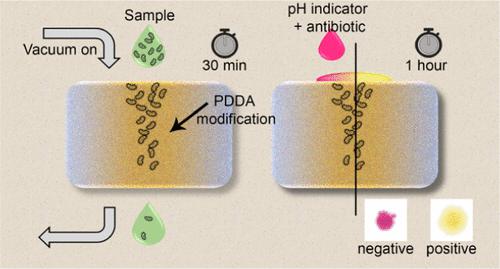当前位置:
X-MOL 学术
›
Anal. Chem.
›
论文详情
Our official English website, www.x-mol.net, welcomes your feedback! (Note: you will need to create a separate account there.)
Rapid Identification and Classification of Pathogens That Produce Carbapenemases and Cephalosporinases with a Colorimetric Paper-Based Multisensor
Analytical Chemistry ( IF 7.4 ) Pub Date : 2022-06-24 , DOI: 10.1021/acs.analchem.2c01724 Giulia Santopolo 1, 2 , Antonio Clemente 1 , Estrella Rojo-Molinero 3, 4 , Antonio Oliver 3, 4 , Camilla Noé 5 , Roberto de la Rica 1, 4
Analytical Chemistry ( IF 7.4 ) Pub Date : 2022-06-24 , DOI: 10.1021/acs.analchem.2c01724 Giulia Santopolo 1, 2 , Antonio Clemente 1 , Estrella Rojo-Molinero 3, 4 , Antonio Oliver 3, 4 , Camilla Noé 5 , Roberto de la Rica 1, 4
Affiliation

|
Infections caused by bacteria that produce β-lactamases (BLs) are a major problem in hospital settings. The phenotypic detection of these bacterial strains requires culturing samples prior to analysis. This procedure may take up to 72 h, and therefore it cannot be used to guide the administration of the first antibiotic regimen. Here, we propose a multisensor for identifying pathogens bearing different types of β-lactamases above the infectious dose threshold within 90 min that does not require culturing samples. Instead, bacterial cells are preconcentrated in the cellulose scaffold of a paper-based multisensor. Then, 12 assays are performed in parallel to identify whether the pathogens produce carbapenemases and/or cephalosporinases, including metallo-β-lactamases, extended-spectrum β-lactamases (ESBLs), and AmpC enzymes. The multisensor generates an array of colored spots that can be quantified with image processing software and whose interpretation leads to the detection of the different enzymes depending on their specificity toward the hydrolysis of certain antibiotics, and/or their pattern of inhibition or cofactor activation. The test was validated for the diagnosis of urinary tract infections. The inexpensive paper platform along with the uncomplicated colorimetric readout makes the proposed prototypes promising for developing fully automated platforms for streamlined clinical diagnosis.
中文翻译:

使用比色纸基多传感器快速识别和分类产生碳青霉烯酶和头孢菌素酶的病原体
由产生 β-内酰胺酶 (BL) 的细菌引起的感染是医院环境中的一个主要问题。这些细菌菌株的表型检测需要在分析之前培养样品。该过程可能需要长达 72 小时,因此不能用于指导第一个抗生素方案的给药。在这里,我们提出了一种多传感器,用于在 90 分钟内识别携带不同类型 β-内酰胺酶高于感染剂量阈值的病原体,无需培养样本。相反,细菌细胞预先集中在纸基多传感器的纤维素支架中。然后,并行进行 12 项检测以确定病原体是否产生碳青霉烯酶和/或头孢菌素酶,包括金属-β-内酰胺酶、超广谱 β-内酰胺酶 (ESBL) 和 AmpC 酶。多传感器生成一系列彩色斑点,这些斑点可以用图像处理软件进行量化,其解释导致不同酶的检测,具体取决于它们对某些抗生素水解的特异性,和/或它们的抑制或辅因子激活模式。该测试已被验证用于诊断尿路感染。廉价的纸质平台以及简单的比色读数使得所提出的原型有望开发用于简化临床诊断的全自动平台。和/或它们的抑制或辅因子激活模式。该测试已被验证用于诊断尿路感染。廉价的纸质平台以及简单的比色读数使得所提出的原型有望开发用于简化临床诊断的全自动平台。和/或它们的抑制或辅因子激活模式。该测试已被验证用于诊断尿路感染。廉价的纸质平台以及简单的比色读数使得所提出的原型有望开发用于简化临床诊断的全自动平台。
更新日期:2022-06-24
中文翻译:

使用比色纸基多传感器快速识别和分类产生碳青霉烯酶和头孢菌素酶的病原体
由产生 β-内酰胺酶 (BL) 的细菌引起的感染是医院环境中的一个主要问题。这些细菌菌株的表型检测需要在分析之前培养样品。该过程可能需要长达 72 小时,因此不能用于指导第一个抗生素方案的给药。在这里,我们提出了一种多传感器,用于在 90 分钟内识别携带不同类型 β-内酰胺酶高于感染剂量阈值的病原体,无需培养样本。相反,细菌细胞预先集中在纸基多传感器的纤维素支架中。然后,并行进行 12 项检测以确定病原体是否产生碳青霉烯酶和/或头孢菌素酶,包括金属-β-内酰胺酶、超广谱 β-内酰胺酶 (ESBL) 和 AmpC 酶。多传感器生成一系列彩色斑点,这些斑点可以用图像处理软件进行量化,其解释导致不同酶的检测,具体取决于它们对某些抗生素水解的特异性,和/或它们的抑制或辅因子激活模式。该测试已被验证用于诊断尿路感染。廉价的纸质平台以及简单的比色读数使得所提出的原型有望开发用于简化临床诊断的全自动平台。和/或它们的抑制或辅因子激活模式。该测试已被验证用于诊断尿路感染。廉价的纸质平台以及简单的比色读数使得所提出的原型有望开发用于简化临床诊断的全自动平台。和/或它们的抑制或辅因子激活模式。该测试已被验证用于诊断尿路感染。廉价的纸质平台以及简单的比色读数使得所提出的原型有望开发用于简化临床诊断的全自动平台。



























 京公网安备 11010802027423号
京公网安备 11010802027423号